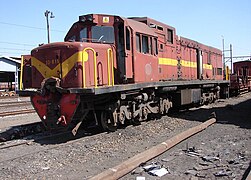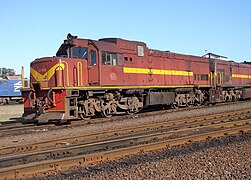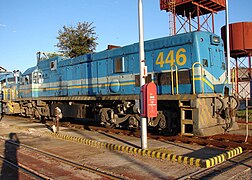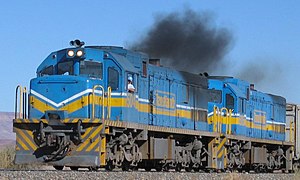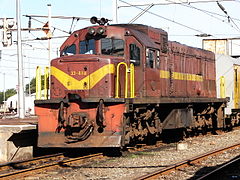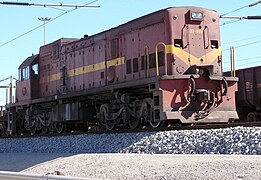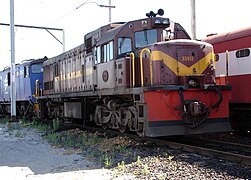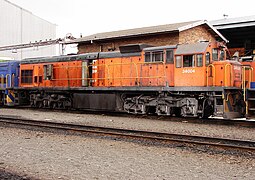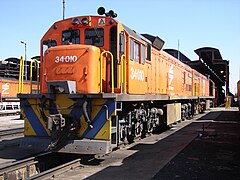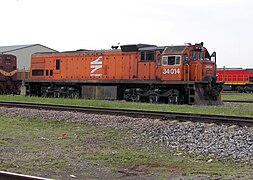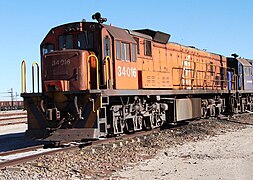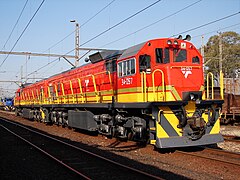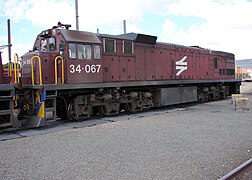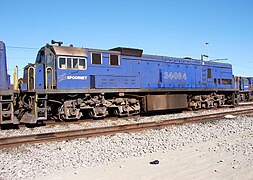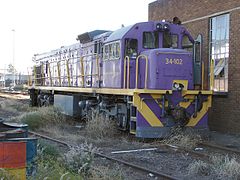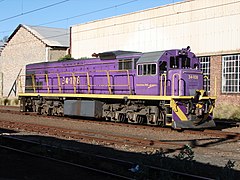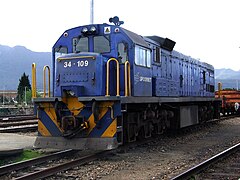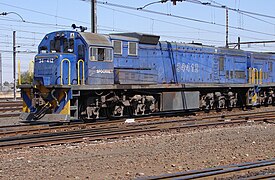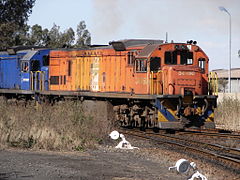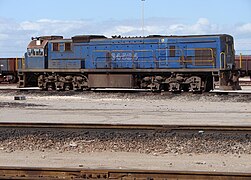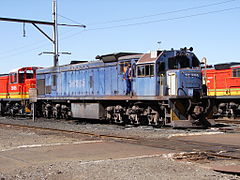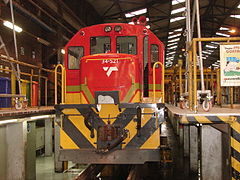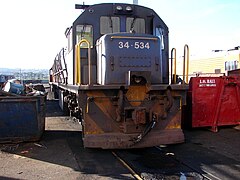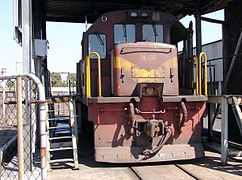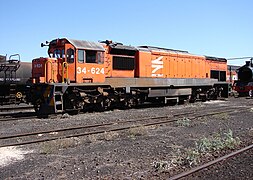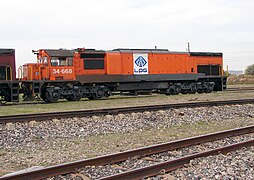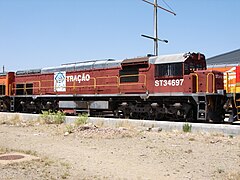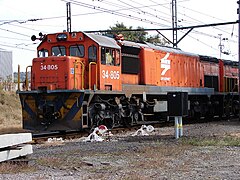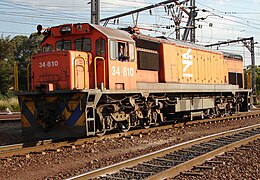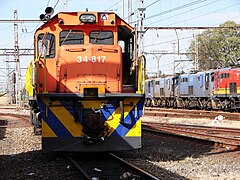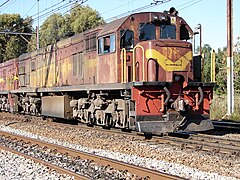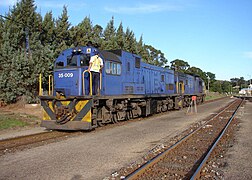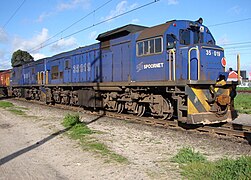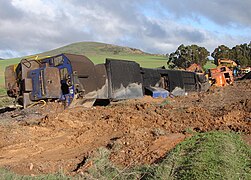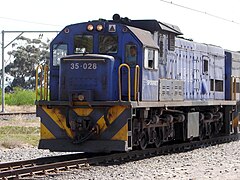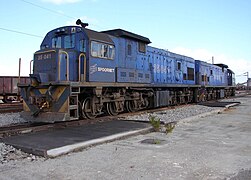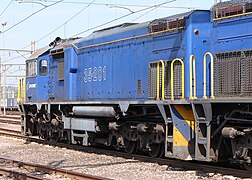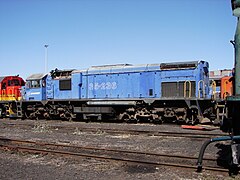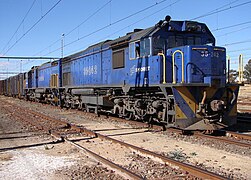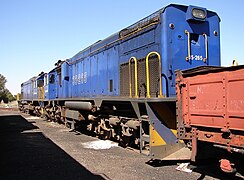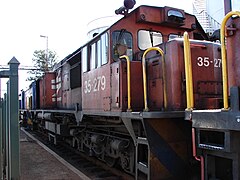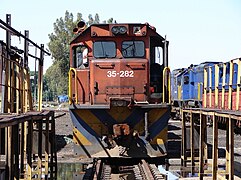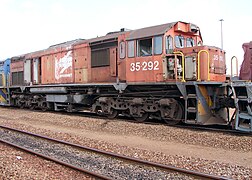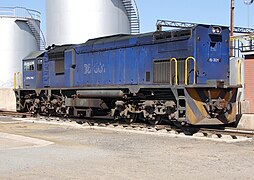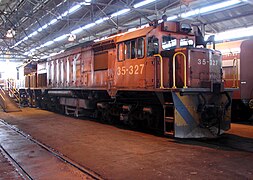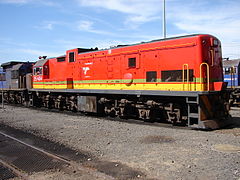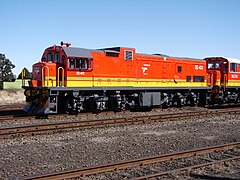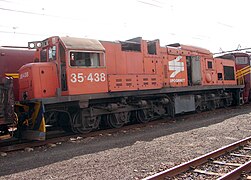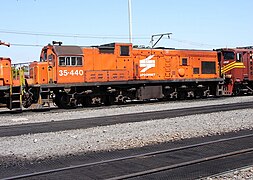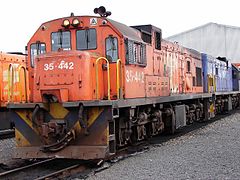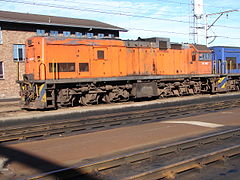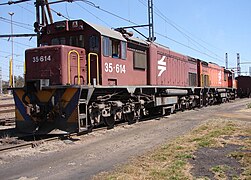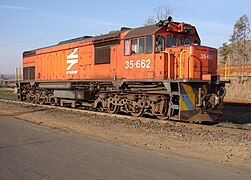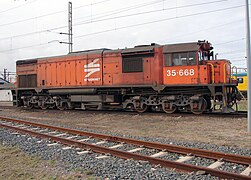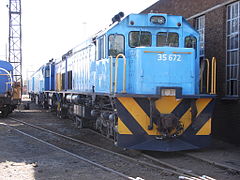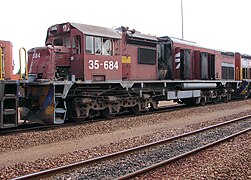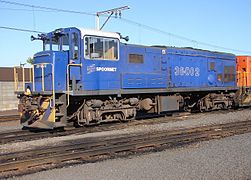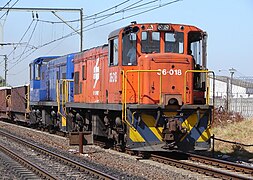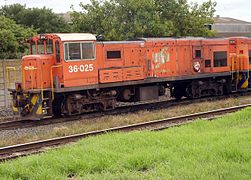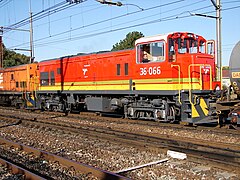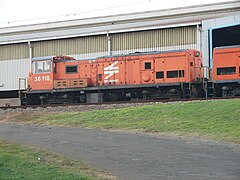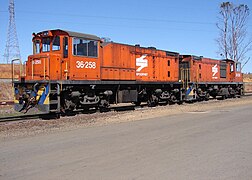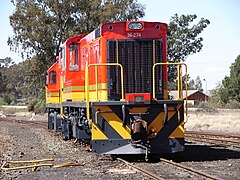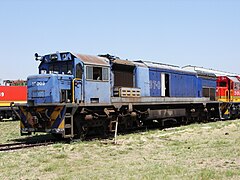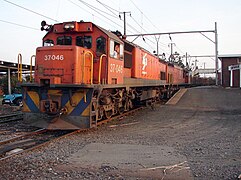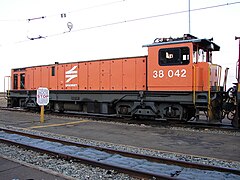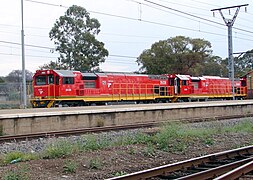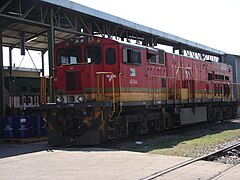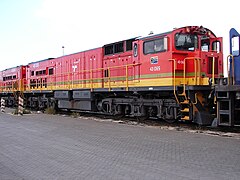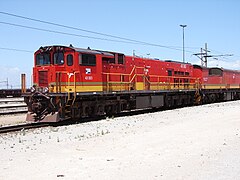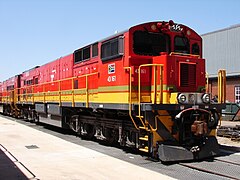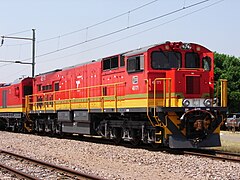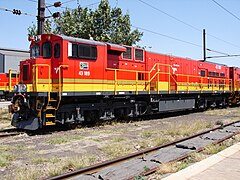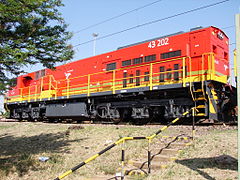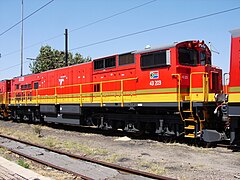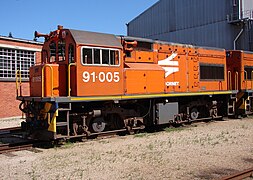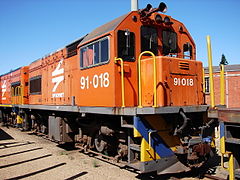User:Andre Kritzinger/South African diesel locomotives
This is a Wikimedia Commons user page.
If you find this page on any site other than Wikimedia Commons, you are viewing a mirror site. Be aware that the page may be outdated, and that the user this page belongs to may have no personal affiliation with any site other than Wikimedia Commons itself. The original page is located at https://commons.wikimedia.org/wiki/User:Andre_Kritzinger/South_African_diesel_locomotives.
|
 |
This is a gallery of diesel-electric, diesel-hydraulic and electro-diesel locomotives of Transnet Freight Rail and the Passenger Rail Agency of South Africa (the former South African Railways, later Spoornet). It shows one picture per locomotive, sorted by class, and occasionally the same locomotive in a different livery. Except where the author's name is indicated in brackets, all the pictures are my own work.
Class 31-000 (GE U12B)
In June and July 1958 the South African Railways placed forty-five Class 31-000 GE U12B diesel-electric locomotives in service. It was designed and built by General Electric and was the first diesel-electric road locomotive class to enter SAR service in quantity. Upon delivery, they were classified as Class 1-DE and numbered in the range from D700 to D744. When a new classification and numbering system for electric and diesel powered locomotives was adopted circa 1960, they were reclassified to Class 31-000 and renumbered in the range from 31-001 to 31-045.
-
31-005, 19 May 2010
(Chris van Wyk) -
31-007, 10 Jan 2009
-
31-028, 31 Oct 2010
Class 32-000 (GE U18C1)
Between November 1959 and November 1961 the South African Railways placed one hundred and fifteen Class 32-000 GE U18C1 diesel-electric locomotives with a 1Co+Co1 wheel arrangement in service in South West Africa. Designed and built to South African Railways requirements by General Electric and imported, they were numbered in the range from 32-001 to 32-115.
-
32-001, 20 Feb 2006
(Alexander Johmann) -
32-013, 30 Sep 1993
(Peter Bagshawe) -
32-021, 5 Dec 2010
(SAR Connecta) -
32-029, 15 Apr 2013
-
32-042, 15 Apr 2013
-
32-047, 15 Apr 2013
-
32-094, 5 Dec 2010
(SAR Connecta)
Class 32-200 (GE U20C1)
In June and July 1966 the South African Railways placed ten Class 32-200 GE U20C1 diesel-electric locomotives in service in South West Africa. It is a more powerful low short hood version of the earlier Class 32-000 and was designed and built to South African Railways requirements by General Electric. They were numbered in the range from 32-201 to 32-210.
-
32-202, 8 Jan 2009
-
32-205, 26 Jun 2010
(John Batwell)
Class 33-000 (GE U20C)
Between June 1965 and January 1966 the South African Railways placed sixty-five Class 33-000 GE U20C diesel-electric locomotives in service. The locomotive was designed and built for the South African Railways by General Electric and imported, numbered in the range from 33-001 to 33-065.
-
33-001, 28 Sep 2006
-
33-002, 20 Oct 2009
-
33-006, 26 Apr 2009
-
33-007, 27 Jun 2009
-
33-008, 24 Apr 2013
-
33-009, 28 Mar 2009
-
33-014, 25 Aug 2007
-
33-015, 25 Aug 2007
-
33-017, 24 Apr 2013
-
33-023, 2 Oct 2009
-
33-025, 28 Mar 2009
-
33-030, 24 May 2009
-
33-030, 9 Oct 2015
-
33-032, 24 Apr 2013
-
33-033, 9 Oct 2009
-
33-042, 2 Oct 2009
-
33-044, 18 Jul 2009
Class 33-200 (EMD GL26MC)
Between October 1966 and May 1967 the South African Railways placed twenty Class 33-200 EMD GL26MC diesel-electric locomotives in service. Designed and built by General Motors Electro-Motive Division, they were delivered with high short hoods and numbered in the range from 33-201 to 33-220. After some were sold, their dynamic braking equipment, located in the high short hood, was removed by the new owners and the short hoods were rebuilt to low noses. Between 1991 and 1992 the remaining Spoornet locomotives were similarly modified and used in shunting service around East London.
-
33-203, 26 Dec 1996
(Nico van der Westhuis) -
33-212, 8 Jan 1970
(Les Pivnic) -
33-215, 26 Dec 1996
(Nico van der Westhuis) -
33-219, 2 Sep 2010
(Redhonda)
Class 33-400 (GE U20C)
Between July 1968 and March 1970 the South African Railways placed one hundred and fifteen Class 33-400 GE U20C diesel-electric locomotives in service. The locomotive was designed by General Electric and built in South Africa by the South African General Electric-Dorman Long Locomotive Group (SA GE-DL, later Dorbyl). They were numbered in the range from 33-401 to 33-515. In 1990 forty-five of them were transferred to TransNamib, the Namibian Railways, where some have since been rebuilt with reconditioned engines and renumbered from number 501 up.
-
33-401, 29 Sep 2011
(Fernando Da Silva Rodrigues) -
33-440, 11 Aug 1984
(Peter Bagshawe) -
33-441, 27 Jun 2008
(Hansueli Krapf) -
33-442, 6 Oct 2011
(Wynand Vermeulen) -
33-445, 28 Jul 2012
(Wynand Vermeulen) -
33-446, 14 May 2006
-
33-453, 6 Oct 2011
(Wynand Vermeulen) -
33-458, 13 Oct 2012
(Amauri Aparecido Zardeto) -
33-460, 6 Oct 2011
(Wynand Vermeulen) -
33-463, 14 May 2006
-
33-468, 6 Oct 2011
(Wynand Vermeulen) -
33-475, 2 Sep 2004
(Harald Süpfle) -
33-488, 24 Apr 2013
-
33-489, 26 Aug 2007
-
33-491, 1 May 2013
-
33-494, 25 Aug 2007
-
33-495, 19 Aug 2010
-
33-498, 25 Aug 2007
-
33-499, 19 Aug 2010
-
33-500, 8 Jan 2009
-
33-500, 1 May 2013
(Mark Berry) -
33-501, 30 Apr 2006
-
33-503, 26 Jul 2009
-
33-504, 24 Apr 2013
-
33-505, 24 Apr 2013
-
33-506, 26 Apr 2009
-
33-507, 20 Aug 2001
(Jezmundo) -
33-508, 25 Oct 2007
-
33-509, 8 Jan 2009
-
33-510, 28 Mar 2009
-
33-511, 20 Oct 2009
-
33-512, 25 Oct 2007
-
33-513, 3 Apr 2006
-
33-515, 26 Apr 2009
Class 34-000 (GE U26C)
Between July 1971 and March 1973 the South African Railways placed one hundred and twenty-five Class 34-000 GE U26C diesel-electric locomotives in service. Designed by General Electric, the first three locomotives were built by GE and imported, numbered in the range from 34-001 to 34-003, while the remainder were built in South Africa by the South African General Electric-Dorman Long Locomotive Group (SA GE-DL, later Dorbyl) and numbered in the range from 34-004 to 34-125.
-
34-001, 19 Aug 2010
-
34-002, 19 Aug 2010
-
34-003, 30 Sep 2009
-
34-004, 6 Jun 2010
-
34-005, 17 Sep 2009
-
34-006, 12 Sep 2007
-
34-007, 3 Oct 2006
-
34-007, 29 Apr 2013
-
34-008, 14 May 2006
-
34-009, 10 Feb 2013
-
34-010, 25 Aug 2007
-
34-011, 6 Jun 2010
-
34-012, 6 Oct 2015
-
34-013, 20 Apr 2013
-
34-014, 2 Oct 2009
-
34-014, 18 May 2013
-
34-015, 14 May 2006
-
34-016, 19 Aug 2010
-
34-017, 3 Oct 2006
-
34-017, 18 Sep 2015
-
34-018, 1 Oct 2009
-
34-019, 16 May 2013
-
34-022, 26 Apr 2013
-
34-023, 10 May 2006
-
34-024, 15 May 2006
-
34-027, 27 May 2013
-
34-033, 18 Sep 2015
-
34-035, 15 Oct 2009
-
34-035, 10 Feb 2013
-
34-036, 14 Oct 2009
-
34-037, 18 Sep 2015
-
34-039, 10 Feb 2013
-
34-040, 18 Sep 2015
-
34-041, 8 Jan 2009
-
34-042, 18 May 2013
-
34-043, 22 Apr 2013
-
34-044, 26 Jul 2009
-
34-045, 20 Apr 2013
-
34-046, 2 Oct 2009
-
34-047, 9 Oct 2009
-
34-048, 9 Oct 2009
-
34-051, 1 May 2013
-
34-052, 7 Oct 2015
-
34-054, 30 Apr 2013
-
34-056, 3 Oct 2015
-
34-057, 14 Oct 2009
-
34-057, 16 May 2013
-
34-058, 1 Sep 1975
(John Middleton) -
34-059, 31 Jan 2013
-
34-060, 25 Aug 2007
-
34-060, 29 Apr 2013
-
34-061, 26 Jul 2009
-
34-062, 19 Aug 2010
-
34-063, 14 Oct 2009
-
34-064, 14 Oct 2009
-
34-064, 18 Sep 2015
-
34-065, 19 Aug 2010
-
34-067, 10 Apr 2006
-
34-069, 26 Jul 2009
-
34-070, 17 Oct 2009
-
34-072, 14 Oct 2009
-
34-073, 15 May 2010
-
34-074, 19 Mar 2011
-
34-075, 14 Oct 2009
-
34-076, 14 Oct 2009
-
34-077, 18 Sep 2015
-
34-078, 26 Jul 2009
-
34-079, 10 Apr 2006
-
34-079, 19 Apr 2013
-
34-080, 19 Aug 2010
-
34-082, 31 Jan 2013
-
34-083, 22 Aug 2007
-
34-084, 19 Aug 2010
-
34-084, 20 Apr 2013
-
34-085, 3 Aug 2007
-
34-086, 19 Aug 2010
-
34-087, 3 Aug 2007
-
34-088, 29 Apr 2013
-
34-090, 12 Sep 2007
-
34-091, 26 Jul 2009
-
34-091, 18 Sep 2015
-
34-092, 7 Oct 2009
-
34-093, 25 May 2005
-
34-093, 17 Oct 2009
-
34-094, 18 Apr 2013
-
34-095, 1 Apr 2005
(Bob Adams) -
34-096, 18 Apr 2013
-
34-097, 3 Aug 2007
-
34-097, 18 Sep 2015
-
34-098, 17 Oct 2009
-
34-099, 25 May 2005
-
34-100, 10 Apr 2006
-
34-101, 14 Oct 2009
-
34-102, 14 Oct 2009
-
34-102, 29 Apr 2013
-
34-103, 2 Oct 2009
-
34-104, 18 Jul 2009
-
34-104, 10 Feb 2013
-
34-105, 12 Sep 2007
-
34-105, 18 Sep 2015
-
34-106, 19 Aug 2010
-
34-106, 9 Oct 2015
-
34-107, 26 Jul 2009
-
34-108, 14 Oct 2009
-
34-108, 10 Oct 2015
-
34-109, 12 Aug 2006
(Bob Adams) -
34-110, 24 May 2013
-
34-111, 18 Sep 2009
-
34-112, 19 Aug 2010
-
34-112, 29 Sep 2015
-
34-113, 26 Jul 2009
-
34-113, 29 Dec 2010
(SAR Connecta) -
34-115, 26 Jul 2009
-
34-115, 26 Sep 2014
(Bob Adams) -
34-116, 22 Sep 2006
-
34-116, 18 Sep 2015
-
34-117, 8 Jan 2009
-
34-118, 8 Jan 2009
-
34-122, 14 Oct 2009
-
34-123, 3 Oct 2006
-
34-123, 18 Sep 2015
-
34-124, 8 Oct 2009
Class 34-200 (EMD GT26MC)
Between October 1971 and March 1972 the South African Railways placed fifty Class 34-200 EMD GT26MC diesel-electric locomotives in service. They were built by Electro-Motive Diesel (EMD) and imported, numbered in the range from 34-201 to 34-250.
-
34-209, 30 Sep 2009
-
34-213, 29 Sep 2015
-
34-215, 10 Jun 2005
-
34-216, 30 Sep 2009
-
34-222, 10 Jun 2005
-
34-224, 10 Jun 2005
-
34-226, 16 Aug 2007
-
34-227, 17 Aug 2007
-
34-232, 7 Apr 2006
-
34-235, 18 Sep 2015
-
34-240, 30 Sep 2009
-
34-241, 14 Aug 2007
Class 34-400 (GE U26C)
Between April 1973 and November 1974 the South African Railways placed one hundred Class 34-400 GE U26C diesel-electric locomotives in service. Numbered in the range from 34-401 to 34-500, the locomotive was designed by General Electric and built by the South African General Electric-Dorman Long Locomotive Group (SA GE-DL, later Dorbyl).
-
34-401, 7 Oct 2009
-
34-402, 7 Apr 2006
-
34-403, 8 Jan 2009
-
34-406, 14 Oct 2009
-
34-407, 1 May 2013
-
34-408, 12 Apr 2006
-
34-411, 19 Aug 2010
-
34-412, 25 Aug 2007
-
34-414, 30 Sep 2006
-
34-415, 2 Oct 2009
-
34-417, 19 Aug 2010
-
34-418, 21 Aug 2007
-
34-418, 10 Feb 2013
-
34-419, 25 Aug 2007
-
34-420, 3 May 2006
-
34-421, 18 May 2013
-
34-422, 18 May 2013
-
34-426, 1 Sep 1975
(John Middleton) -
34-427, 9 Oct 2009
-
34-430, 9 Oct 2009
-
34-431, 3 Oct 2006
-
34-432, 18 Apr 2013
-
34-434, 23 Sep 2009
-
34-435, March 1982
(John Middleton) -
34-440, 15 Oct 2009
-
34-441, 19 Aug 2010
-
34-443, 17 Oct 2009
-
34-446, 6 Jun 2010
-
34-449, 12 Apr 2006
-
34-450, 25 Aug 2007
-
34-455, 29 Apr 2013
-
34-456, 7 Apr 2006
-
34-459, 12 Oct 2009
-
34-460, 18 Sep 2015
-
34-461, 18 May 2013
-
34-463, 21 Jul 2009
-
34-464, 21 Aug 2007
-
34-465, 30 Sep 2006
-
34-469, 19 Aug 2010
-
34-470, 17 Sep 2009
-
34-471, 19 Aug 2010
-
34-472, 14 Jul 2011
-
34-473, 6 Oct 2015
-
34-475, 26 Apr 2009
-
34-476, 26 Jul 2009
-
34-478, 12 Sep 2007
-
34-479, 18 May 2013
-
34-480, 15 May 2010
-
34-484, 7 Apr 2006
-
34-487, 10 Feb 2013
-
34-488, 13 Nov 2014
-
34-492, 19 Aug 2010
-
34-494, 20 Apr 2013
-
34-496, 18 Apr 2013
-
34-497, 24 Apr 2013
-
34-498, 12 Sep 2007
-
34-499, 22 Aug 2007
Class 34-500 (GE U26C)
Between 1974 and 1977 Iscor placed forty-four GE U26C diesel-electric locomotives in service on the Sishen-Saldanha iron ore line. The locomotives were designed by General Electric and built in three batches by the South African General Electric-Dorman Long Locomotive Group (SA GE-DL, later Dorbyl). In 1977 and 1978 thirty-nine of them were transferred to the South African Railways, where they were initially reclassified to Class 34-400 ex Iscor and renumbered in the range from 34-501 to 34-539. They later became commonly known as Class 34-500.
-
34-501, 26 Jul 2009
-
34-501, 20 Apr 2013
-
34-502, 26 Jul 2009
-
34-503, 26 Jul 2009
-
34-504, 12 Sep 2007
-
34-505, 18 Sep 2015
-
34-506, 26 Jul 2009
-
34-507, 14 Jul 2011
-
34-509, 14 Jul 2011
-
34-509, 18 Sep 2015
-
34-510, 12 Sep 2007
-
34-512, 25 Oct 2007
-
34=513, 19 Aug 2010
-
34-514, 7 Apr 2006
-
34-514, 12 Sep 2007
-
34-515, 18 Sep 2015
-
34-516, 19 Aug 2010
-
34-517, 26 Jul 2009
-
34-518, 18 Jul 2009
-
34-519, 25 Oct 2007
-
34-521, 8 Jan 2009
-
34-521, 18 Apr 2013
-
34-522, 12 Sep 2007
-
34-523, 14 Jul 2011
-
34-524, 19 Aug 2010
-
34-525, 10 Feb 2013
-
34-526, 13 Nov 2014
-
34-527, 10 Jan 2009
-
34-528, 13 Nov 2014
-
34-529, 12 Sep 2007
-
34-530, 12 Sep 2007
-
34-531, 11 Nov 2014
-
34-532, 18 Sep 2015
-
34-533, 10 Feb 2013
-
34-534, 26 Apr 2009
-
34-535, 26 Jul 2009
-
34-536, 26 Jan 2010
-
34-537, 11 Nov 2014
-
34-538, 26 Apr 2009
-
34-538, 10 Feb 2013
-
34-539, 26 Jul 2009
-
G04, 5 Sep 2010
(Logan Stone)
Class 34-600 (EMD GT26MC)
Between December 1974 and July 1976 the South African Railways placed one hundred Class 34-600 EMD GT26MC diesel-electric locomotives in service. Designed by Electro-Motive Diesel, they were built by General Motors South Africa in Port Elizabeth and numbered in the range from 34-601 to 34-700. Beginning in 2005 three Class 39-000 EMD GT26CU-3 locomotives, numbers 39-001, 39-003 and 39-004, were rebuilt from wrecked Class 34-600 locomotives, numbers 34-635, 34-674 and 34-620 respectively.
-
34-601, 22 Sep 2015
-
34-610, 20 May 2011
(Railfan) -
34-612, 14 Aug 2007
-
34-613, 14 Aug 2007
-
34-614, 14 Aug 2007
-
34-615, 14 Aug 2007
-
34-622, 29 Apr 2013
-
34-624, 14 Oct 2009
-
34-633, 27 Sep 2015
-
34-650, 6 May 2013
-
34-651, 30 Sep 2009
-
34-652, 1 Oct 2009
-
34-660, 22 Feb 1992
(Peter Bagshawe) -
34-668, 2 Oct 2009
-
34-672, 6 Oct 2009
-
34-691, 30 Sep 2009
-
34-694, 10 May 2013
-
34-697, 27 Sep 2015
Class 34-800 (EMD GT26MC)
Between August 1978 and July 1980 the South African Railways placed fifty-eight Class 34-800 EMD GT26MC diesel-electric locomotives in service. Designed by Electro-Motive Diesel, they were built in two batches by General Motors South Africa in Port Elizabeth and numbered in the range from 34-801 to 34-858. Beginning in 2006 two Class 39-000 EMD GT26CU-3 locomotives, numbers 39-002 and 39-005, were rebuilt from wrecked Class 34-800 locomotives, numbers 34-838 and 34-829 respectively.
-
34-805, 10 May 2013
-
34-806, 6 Oct 2009
-
34-808, 30 Sep 2009
-
34-810, 9 May 2006
-
34-811, 28 Sep 2006
-
34-813, 28 Sep 2006
-
34-814, 16 May 2013
-
34-815, 30 Sep 2009
-
34-817, 10 May 2013
-
34-819, 2 Oct 2009
-
34-824, 15 May 2013
-
34-836, 30 Sep 2009
-
34-839, 29 Sep 2009
-
34-847, 18 Sep 2015
-
34-849, 6 Oct 2009
-
34-852, 28 Sep 2006
-
34-857, 18 Sep 2015
Class 34-900 (GE U26C)
Between October 1979 and February 1981 the South African Railways placed thirty Class 34-900 GE U26C diesel-electric locomotives in service, numbered in the range from 34-901 to 34-930. The GE U26C was designed by General Electric and built by the South African General Electric-Dorman Long Locomotive Group (SA GE-DL, later Dorbyl).
-
34-901, 19 Aug 2010
-
34-902, 26 Jul 2009
-
34-903, 19 Aug 2010
-
34-904, 30 Apr 2013
-
34-906, 27 Jun 2009
-
34-907, 12 Sep 2007
-
34-908, 19 Aug 2010
-
34-909, 19 Aug 2010
-
34-910, 24 May 2009
-
34-911, 30 Apr 2013
-
34-912, 24 May 2013
-
34-913, 25 Oct 2007
-
34-913, 17 Sep 2015
-
34-914, 12 Sep 2007
-
34-916, 26 Jul 2009
-
34-917, 25 Oct 2007
-
34-918, 14 Jul 2010
-
34-919, 19 Mar 2011
-
34-920, 7 Oct 2015
-
34-921, 1 Oct 2009
-
34-922, 18 Sep 2015
-
34-924, 26 Jul 2009
-
34-925, 19 Aug 2010
-
34-926, 15 May 2010
-
34-927, 19 Aug 2010
-
34-928, 24 Aug 2007
-
34-929, 24 Aug 2007
-
34-930, 18 Sep 2009
Class 35-000 (GE U15C)
Between March 1972 and May 1973 the South African Railways placed seventy Class 35-000 GE U15C diesel-electric locomotives in service. The locomotive was designed and built in two batches by General Electric, fifty locomotives in 1972 and another twenty in 1973. They were numbered in the range from 35-001 to 35-070.
-
35-001, 16 Mar 2007
-
35-003, 18 Jul 2009
-
35-004, 26 Jul 2009
-
35-005, 4 Sep 2007
-
35-008, 8 Nov 2006
-
35-009, 16 May 2006
-
35-009, 12 Jan 2015
-
35-012, 12 Jul 2007
-
35-016, 13 Apr 2006
-
35-018, 27 Aug 2007
-
35-019, 19 Jul 2006
-
35-020, 10 Feb 2013
-
35-021, 1 Sep 2006
-
35-026, 25 Oct 2007
-
35-027, 9 Jun 2007
-
35-028, 16 Jan 2007
-
35-029, 3 Apr 2010
-
35-031, 7 Apr 2006
-
35-032, 29 Mar 2006
-
35-033, 1 Oct 2004
(Bob Adams) -
35-034, 26 Apr 2009
-
35-035, 17 Jan 2007
-
35-037, 12 Apr 2007
-
35-038, 28 Mar 2006
-
35-038, 17 Nov 2006
-
35-039, 17 Oct 2009
-
35-040, 22 Nov 2007
-
35-041, 12 Sep 2007
-
35-042, 28 Mar 2006
-
35-043, 26 Jul 2009
-
35-044, 22 Jan 2007
-
35-045, 3 Apr 2010
-
35-046, 23 May 2007
-
35-047, 30 Apr 2006
-
35-048, 2 Oct 2007
-
35-053, 15 May 2010
-
35-054, 26 Apr 2009
-
35-057, 12 Apr 2007
-
35-058, 14 Dec 2006
-
35-059, 31 Jan 2013
-
35-060, 26 Apr 2009
-
35-061, 26 Jul 2009
-
35-062, 12 Feb 2007
-
35-063, 12 Feb 2007
-
35-064, 17 Oct 2009
-
35-065, 21 Apr 2013
-
35-066, 9 Jun 2007
-
35-067, 22 Mar 2007
-
35-068, 18 Jul 2009
-
35-070, 17 Oct 2009
Class 35-200 (EMD GT18MC)
Between November 1974 and August 1976 the South African Railways placed one hundred and fifty Class 35-200 EMD GT18MC diesel-electric locomotives in service. Designed by Electro-Motive Diesel, the first twenty-five were built by EMD and imported in 1974. The remainder was built in two batches by General Motors South Africa in Port Elizabeth in 1975 and 1976. One was also built for AECI in Modderfontein, Johannesburg in 1975.
-
35-201, 1 Oct 2009
-
35-203, 9 May 2006
-
35-204, 14 Aug 2007
-
35-208, 10 May 2006
-
35-209, 29 Sep 2006
-
35-211, 20 May 2013
-
35-213, 29 Apr 2013
-
35-214, 29 Apr 2013
-
35-215, 18 Sep 2009
-
35-217, 23 Aug 2007
-
35-218, 7 Oct 2015
-
35-220, 30 Sep 2009
-
35-222, 25 Aug 2007
-
35-224, 14 Oct 2009
-
35-226, 1 Oct 2009
-
35-230, 24 Apr 2013
-
35-231, 10 May 2006
-
35-232, 30 Sep 2009
-
35-234, 10 May 2006
-
35-236, 18 Sep 2015
-
35-237, 4 Oct 2006
-
35-238, 23 Aug 2007
-
35-239, 20 Sep 2009
-
35-240, 25 Aug 2007
-
35-241, 5 Oct 2006
-
35-242, 24 Aug 2007
-
35-246, 29 Sep 2015
-
35-248, 20 Sep 2009
-
35-249, 14 Oct 2009
-
35-250, 18 Sep 2015
-
35-251, 1 Oct 2009
-
35-254, 17 Sep 2009
-
35-258, 14 Oct 2009
-
35-261, 29 Apr 2013
-
35-263, 1 May 2013
-
35-264, 5 Oct 2006
-
35-264, 30 Apr 2013
-
35-265, 14 Oct 2009
-
35-266, 25 Aug 2007
-
35-267, 18 Sep 2009
-
35-268, 25 Aug 2007
-
35-271, 20 Aug 2007
-
35-271, 28 Sep 2015
-
35-272, 10 May 2006
-
35-273, 29 Apr 2013
-
35-274, 14 Oct 2009
-
35-275, 3 Oct 2006
-
35-276, 10 May 2006
-
35-278, 29 Apr 2013
-
35-279, 14 Oct 2009
-
35-280, 14 Oct 2009
-
35-282, 14 Oct 2009
-
35-283, 9 May 2006
-
35-288, 24 Apr 2013
-
35-292, 30 Sep 2009
-
35-294, 21 Aug 2007
-
35-294, 7 Oct 2015
-
35-295, 7 Apr 2006
-
35-299, 8 Oct 2015
-
35-300, 7 Apr 2006
-
35-301, 14 Oct 2009
-
35-303, 18 Sep 2015
-
35-310, 30 Sep 2009
-
35-311, 20 May 2013
-
35-317, 24 Apr 2013
-
35-322, 24 Apr 2013
-
35-325, 10 May 2006
-
35-327, 23 Aug 2007
-
35-328, 30 Sep 2009
-
35-330, 18 Aug 2007
-
35-330, 26 Sep 2015
-
35-331, 18 Aug 2007
-
35-331, 28 Sep 2015
-
35-332, 14 Oct 2009
-
35-334, 30 Apr 2013
-
35-337, 30 Sep 2009
-
35-338, 11 Jun 2005
-
35-340, 24 Apr 2013
-
35-341, 12 Oct 2009
-
35-341, 29 Sep 2015
-
35-343, 23 Aug 2007
-
35-344, 7 Apr 2006
-
35-347, 30 Sep 2009
-
35-348, 27 Jan 2010
(Jezmundo) -
35-348, 8 Oct 2015
-
35-349, 23 Aug 2007
-
35-350, 25 Aug 2007
Class 35-400 (GE U15C)
Between March 1976 and May 1980 the South African Railways placed one hundred Class 35-400 GE U15C diesel-electric locomotives in service, numbered in the range from 35-401 to 35-500. Designed by General Electric, they were built in two batches by the South African General Electric-Dorman Long Locomotive Group (SA GE-DL, later Dorbyl).
-
35-401, 16 Aug 2006
-
35-403, 19 Oct 2006
-
35-404, 31 Jan 2013
-
35-405, 11 Aug 2005
-
35-406, 13 Mar 2007
-
35-407, 6 Oct 2006
-
35-408, 22 Jan 2007
-
35-410, 21 Jul 2009
-
35-411, 18 Sep 2015
-
35-413, 26 Mar 2013
-
35-415, 24 May 2009
-
35-417, 3 Apr 2010
-
35-425, 26 Jun 2007
-
35-426, 28 Sep 2009
-
35-428, 28 Sep 2009
-
35-431, 15 May 2010
-
35-431, 7 Oct 2015
-
35-435, 18 Jul 2009
-
35-438, 5 Aug 2007
-
35-439, 13 Jan 2010
-
35-440, 26 Jan 2010
-
35-440, 12 Oct 2015
-
35-442, 6 Jun 2010
-
35-443, 3 Apr 2010
-
35-444, 26 Jun 2007
-
35-446, 15 May 2010
-
35-449, 21 Jul 2009
-
35-458, 7 Apr 2006
-
35-465, 26 Jan 2010
-
35-467, 24 May 2009
-
35-469, 8 Jan 2009
-
35-471, 31 Oct 2010
-
35-473, 10 Jan 2009
-
35-475, 10 Jan 2009
-
35-482, 9 Aug 2012
-
35-483, 26 Mar 2013
-
35-485, 29 Jan 2012
-
35-494, 25 Jul 2010
-
35-499, 26 Apr 2009
Class 35-600 (EMD GT18MC)
Between September 1976 and June 1978 the South African Railways placed one hundred Class 35-600 EMD GT18MC diesel-electric locomotives in service. Designed by Electro-Motive Diesel, they were built in two batches by General Motors South Africa in Port Elizabeth, numbered in the ranges 35-601 to 35-650 and 35-651 to 35-700. A single Class 35-600 GT18MC locomotive was also built new in 1977 for Columbus Stainless in Middelburg, Transvaal.
-
35-601, 5 May 2006
-
35-602, 18 Sep 2015
-
35-603, 7 Apr 2006
-
35-608, 14 Aug 2007
-
35-614, 20 Aug 2007
-
35-618, 10 May 2006
-
35-619, 4 May 2006
-
35-622, 30 Sep 2009
-
35-624, 30 Apr 2013
-
35-625, 5 Oct 2009
-
35-628, 2 Oct 2006
-
35-630, 6 Aug 2007
-
35-631, 1 Oct 2009
-
35-635, 14 Oct 2009
-
35-637, 18 Sep 2015
-
35-640, 6 Aug 2007
-
35-641, 28 Sep 2015
-
35-644, 9 May 2013
-
35-645, 5 May 2006
-
35-647, 30 Sep 2009
-
35-653, 15 Aug 2007
-
35-661, 10 May 2006
-
35-662, 15 Aug 2007
-
35-662, 26 Sep 2015
-
35-665, 7 Oct 2015
-
35-668, 12 Aug 2007
-
35-671, 8 Nov 2011
(Jaco Marais) -
35-672, 18 Sep 2015
-
35-683, 18 Sep 2015
-
35-684, 30 Sep 2009
-
35-687, 7 Apr 2006
-
35-689, 29 Apr 2013
-
35-693, 30 Sep 2009
-
35-696, 15 Aug 2007
-
35-697, 30 Sep 2009
-
35-699, 15 Aug 2007
-
35-700, 11 Jun 2005
Class 35-800 (EMD GL26C-2)
In October 2014 Transnet Freight Rail and Transnet Engineering purchased fourteen used ex Queensland Railways 2170 Class Clyde/EMD GL26C-2 diesel-electric locomotives from Aurizon Holdings Limited, a publicly listed rail freight company in Australia. Designated Class 35-800, it is understood that they will be mainly employed in yard and shop work at various centres around the country.
-
2174D, 22 Sep 2015
-
2180D, 7 Oct 2015
-
2202D, 22 Sep 2015
-
2210D, 29 Sep 2015
Class 36-000 (GE SG10B)
Between June 1975 and 1981 the South African Railways placed one hundred and twenty-four Class 36-000 GE SG10B diesel-electric locomotives in service, numbered in the range from 36-001 to 36-124. Designed by General Electric, they were built in three batches by the South African General Electric-Dorman Long Locomotive Group (SA GE-DL, later Dorbyl). The first one hundred locomotives were delivered by September 1978, followed in 1981 by two batches of twenty and four locomotives respectively.
-
36-001, 17 Mar 2006
-
36-001, 23 May 2007
-
36-002, 21 Aug 2003
-
36-002, 28 Mar 2009
-
36-003, 13 Jan 2005
-
36-003, 21 Jul 2009
-
36-003, 2 Apr 2015
-
36-004, 21 Apr 2006
-
36-004, 27 Jun 2009
-
36-005, 3 Jul 2006
-
36-006, 15 May 2010
-
36-007, 21 Mar 2007
-
36-007, 11 Oct 2015
-
36-008, 26 Apr 2009
-
36-009, 25 Oct 2007
-
36-009, 12 Oct 2015
-
36-010, 12 Apr 2007
-
36-011, 19 Apr 2006
-
36-012, 26 Apr 2009
-
36-013, 3 Apr 2010
-
36-013, 4 Nov 2013
-
36-014, 21 Mar 2007
-
36-015, 6 Jun 2010
-
36-015, 14 Sep 2015
-
36-016, 6 Jun 2010
-
36-016, 15 Oct 2015
-
36-017, 15 Mar 2007
-
36-017, 31 Jan 2013
-
36-018, 22 Jan 2007
-
36-019, 14 Mar 2006
-
36-020, 22 Mar 2007
-
36-021, 21 Apr 2006
-
36-022, 7 May 2007
-
36-022, 15 Oct 2015
-
36-023, 15 May 2010
-
36-024, 12 Oct 2009
-
36-025, 10 Jan 2009
-
36-026, 23 Aug 2007
-
36-027, 15 Oct 2015
-
36-028, 3 May 2006
-
36-034, 30 May 2005
-
36-039, 17 Oct 2009
-
36-039, 29 Apr 2013
-
36-041, 14 Oct 2009
-
36-041, 21 Apr 2013
-
36-042, 17 Oct 2009
-
36-043, 17 Oct 2009
-
36-044, 19 Apr 2013
-
36-045, 19 Apr 2013
-
36-046, 10 Feb 2013
-
36-047, 17 Oct 2009
-
36-047, 21 Apr 2013
-
36-049, 24 May 2009
-
36-051, 18 Apr 2013
-
36-052, 17 Oct 2009
-
36-053, 17 Oct 2009
-
36-053, 18 Apr 2013
-
36-054, 17 Oct 2009
-
36-055, 12 Sep 2007
-
36-056, 13 Nov 2014
-
36-060, 17 Oct 2009
-
36-061, 7 Apr 2006
-
36-062, 23 Aug 2007
-
36-063, 18 Sep 2015
-
36-064, 18 Sep 2015
-
36-065, 14 Oct 2009
-
36-065, 18 Sep 2015
-
36-066, 14 Oct 2009
-
36-066, 30 Apr 2013
-
36-067, 26 Jul 2009
-
36-067, 13 Nov 2014
-
36-068, 30 Apr 2013
-
36-069, 29 Apr 2013
-
36-077, 23 Sep 2009
-
36-080, 3 May 2006
-
36-081, 8 Oct 2009
-
36-085, 3 May 2006
-
36-092, 29 Sep 2009
-
36-097, 24 Jun 2005
-
36-098, 30 May 2005
-
36-100, 12 Oct 2009
-
36-101, 24 Sep 2009
-
36-102, 29 Sep 2009
-
36-107, 22 Sep 2009
-
36-111, 29 Sep 2009
-
36-111, 28 Sep 2015
-
36-112, 28 Sep 2015
-
36-115, 29 Sep 2009
-
36-116, 8 Oct 2009
-
36-117, 8 Oct 2009
-
36-118, 18 May 2013
-
36-122, 22 Sep 2009
-
36-124, 18 May 2013
Class 36-200 (EMD SW1002)
Between 1980 and 1984 the South African Railways placed 101 Class 36-200 EMD SW1002 diesel-electric locomotives in service. Designed by Electro-Motive Diesel, they were built in two batches by General Motors South Africa in Port Elizabeth and numbered in the range from 36-201 to 36-301. In 1984 one was also built for the Bophuthatswana National Development Corporation, while three were placed in service by Iscor in Pretoria between 1986 and 1991, and another two by the Ithala Development Finance Corporation in KwaZulu-Natal in 1987.
-
36-201, 5 Aug 2007
-
36-202, 11 Aug 2007
-
36-205, 11 Aug 2007
-
36-208, 5 Aug 2007
-
36-209, 12 Aug 2007
-
36-214, 7 Aug 2007
-
36-217, 29 Sep 2006
-
36-217, 26 Sep 2015
-
36-219, 12 Aug 2007
-
36-220, 8 Aug 2007
-
36-223, 22 Jun 2005
-
36-225, 7 Aug 2007
-
36-226, 8 Aug 2007
-
36-228, 12 Aug 2007
-
36-230, 7 Aug 2007
-
36-233, 8 Aug 2007
-
36-240, 12 Aug 2007
-
36-242, 7 Aug 2007
-
36-244, 8 Aug 2007
-
36-246, 8 Aug 2007
-
36-247, 17 Aug 2007
-
36-248, 17 Aug 2007
-
36-251, 26 May 2010
(SAR Connecta) -
36-254, 16 May 2013
-
36-255, 15 Aug 2007
-
36-256, 29 Apr 2013
-
36-257, 8 Aug 2007
-
36-258, 16 Aug 2007
-
36-263, 10 May 2013
-
36-264, 10 May 2006
-
36-266, 10 May 2006
-
36-267, 2 Oct 2006
-
36-268, 2 Oct 2006
-
36-269, 1 Oct 2009
-
36-274, 18 Sep 2015
-
36-279, 10 May 2013
-
36-280, 10 May 2013
-
36-284, 29 Sep 2006
-
36-285, 1 Oct 2009
-
36-293, 9 May 2006
-
36-295, 1 Oct 2009
-
36-296, 22 Jun 2005
-
36-297, 27 Mar 2013
-
36-298, 30 Sep 2009
-
36-299, 28 Sep 2006
-
36-301, 29 Sep 2006
Class 37-000 (EMD GT26M2C)
Between May 1981 and 1982 the South African Railways placed one hundred Class 37-000 EMD GT26M2C diesel-electric locomotives in service. It is a more powerful version of the EMD Class 34-200, 34-600 and 34-800, designed by Electro-Motive Diesel and built by General Motors South Africa in Port Elizabeth. They were numbered in the range from 37-001 to 37-100.
-
37-001, 14 Aug 2007
-
37-003, 29 Sep 2015
-
37-005, 9 Oct 2009
-
37-005, 19 Jul 2011
(Railfan) -
37-014, 16 May 2013
-
37-020, 15 Aug 2007
-
37-024, 15 Aug 2007
-
37-038, 8 Aug 2007
-
37-046, 14 Aug 2007
-
37-047, 14 Aug 2007
-
37-055, 30 Sep 2009
-
37-063, 2 Oct 2009
-
37-076, 29 Sep 2015
-
37-081, 29 Sep 2015
-
37-084, 30 Sep 2009
-
37-086, 7 Apr 2006
-
37-089, 10 May 2006
-
37-096, 14 Aug 2007
Class 38-000
Between 1992 and 1994 Spoornet placed fifty Class 38-000 locomotives in service, numbered in the range from 38-001 to 38-050. It was designed for Spoornet by a Consortium led by Siemens and built by Union Carriage and Wagon in Nigel, Transvaal. They are dual powered electro-diesel locomotives, capable of running either on 3 kV electricity off the catenary or on diesel alone. In 1992 three Class E38 locomotives were also built for Amcoal Mines for use at the Landau Colliery near Witbank, Mpumalanga, numbered in the range from E38-001 to E38-003. These are electric locomotives identical in appearance to the Class 38-000, but designed for 3 kV electric operation only.
-
38-001, 7 Oct 2009
-
38-003, 29 Sep 2009
-
38-004, 28 Sep 2015
-
38-005, 22 Sep 2009
-
38-006, 28 Sep 2006
-
38-008, 22 Sep 2009
-
38-009, 22 Sep 2009
-
38-011, 9 Oct 2009
-
38-012, 28 Sep 2006
-
38-012, 18 May 2013
-
38-014, 28 Sep 2015
-
38-018, 3 Oct 2006
-
38-020, 21 Aug 2007
-
38-020, 28 Sep 2015
-
38-021, 8 Oct 2009
-
38-022, 28 Sep 2015
-
38-024, 28 Sep 2015
-
38-026, 22 Sep 2009
-
38-027, 22 Sep 2009
-
38-030, 29 Sep 2015
-
38-031, 22 Sep 2009
-
38-032, 21 Aug 2007
-
38-033, 29 Sep 2009
-
38-034, 8 Oct 2009
-
38-035, 8 Oct 2009
-
38-036, 22 Sep 2009
-
38-037, 22 Sep 2009
-
38-039, 28 Sep 2015
-
38-040, 29 Sep 2009
-
38-041, 28 Sep 2015
-
38-042, 18 May 2013
-
38-043, 22 Sep 2009
-
38-044, 8 Oct 2009
-
38-044, 28 Sep 2015
-
38-045, 22 Sep 2009
-
38-050, 22 Sep 2009
Class 39-000 (EMD GT26CU-3)
In 2005 Transwerk commenced a project at its Bloemfontein shops of rebuilding one hundred existing Class 34-600 and 34-800 EMD GT26MC and Class 37-000 EMD GT26M2C locomotives to new Class 39-000 EMD GT26CU-3 locomotives for Spoornet. Only five were eventually rebuilt and placed in service between April 2006 and 2009, numbered in the range from 39-001 to 39-005. (In 2008 Class 37-000 no. 37-010 had been rebuilt to Class 39 prototype no. 39-251 that was tested but rejected by Transnet and later reported as sold to RRL.)
-
39-001, 24 Apr 2007
(Railfan) -
39-002, 7 May 2013
-
39-003, 13 May 2013
-
39-004, 13 May 2013
-
39-005, 7 May 2013
-
39-251, 11 Jul 2013
(Redhonda)
Class 39-200 (EMD GT26CU-3)
In 2010 fifty Class 39-200 type EMD GT26CU-3 diesel-electric locomotives were placed in service by Transnet Freight Rail, numbered in the range from 39-201 to 39-250. They were built new at the Koedoespoort Transnet Rail Engineering shops, in collaboration with Electro-Motive Diesel. The last of the fifty locomotives came off the production line in April 2010.
-
39-201, 2 Oct 2009
-
39-202, 2 Oct 2009
-
39-203, 2 Oct 2009
-
39-204, 2 Oct 2009
-
39-205, 9 Oct 2009
-
39-206, 2 Oct 2009
-
39-207, 2 Oct 2009
-
39-208, 5 Oct 2009
-
39-209, 30 Sep 2009
-
39-210, 2 Oct 2009
-
39-211, 2 Oct 2009
-
39-212, 2 Oct 2009
-
39-213, 2 Oct 2009
-
39-214, 9 Oct 2009
-
39-215, 9 Oct 2009
-
39-216, 9 Oct 2009
-
39-217, 2 Oct 2009
-
39-218, 2 Oct 2009
-
39-219, 9 Oct 2009
-
39-220, 9 Oct 2009
-
39-224, 2 Oct 2009
-
39-226, 7 May 2013
-
39-242, 14 May 2013
-
39-246, 28 Sep 2015
Class 43-000 (GE C30ACi)
In 2011 the first ten Class 43-000 type GE C30ACi diesel-electric locomotives for Transnet Freight Rail were imported from the United States of America, built by GE Transportation Systems and numbered in the range from 43-001 to 43-010. The rest of the Class, numbered in the range from 43-011 up, were built at the Koedoespoort shops of Transnet Rail Engineering from 2011. The C30ACi was the first AC diesel electric locomotive to be introduced in sub-Saharan Africa.
-
43-001, 28 Jan 2011
(SAR Connecta) -
43-002, 29 Sep 2015
-
43-005, 29 Sep 2015
-
43-011, 19 Jul 2011
(Railfan) -
43-044, 29 Sep 2015
-
43-051, 29 Sep 2015
-
43-063, 5 Oct 2015
-
43-064, 10 Feb 2013
-
43-065, 10 Feb 2013
-
43-067, 11 Nov 2014
-
43-070, 10 Feb 2013
-
43-071, 13 Nov 2014
-
43-073, 11 Nov 2014
-
43-074, 5 Oct 2015
-
43-078, 13 Nov 2014
-
43-079, 13 Nov 2014
-
43-080, 5 Oct 2015
-
43-083, 13 Nov 2014
-
43-084, 10 Feb 2013
-
43-092, 11 Nov 2014
-
43-116, 14 May 2013
-
43-121, 14 May 2013
-
43-124, 14 May 2013
-
43-142, 27 Sep 2015
-
43-143, 22 Sep 2015
-
43-144, 22 Sep 2015
-
43-145, 27 Sep 2015
-
43-152, 27 Sep 2015
-
43-158, 27 Sep 2015
-
43-159, 22 Sep 2015
-
43-161, 27 Sep 2015
-
43-171, 22 Sep 2015
-
43-174, 27 Sep 2015
-
43-179, 27 Sep 2015
-
43-181, 22 Sep 2015
-
43-184, 22 Sep 2015
-
43-186, 27 Sep 2015
-
43-187, 27 Sep 2015
-
43-188, 27 Sep 2015
-
43-189, 27 Sep 2015
-
43-191, 22 Sep 2015
-
43-193, 27 Sep 2015
-
43-202, 22 Sep 2015
-
43-203, 27 Sep 2015
Class 44-000 (GE ES40ACi)
In 2015 the first six Class 44-000 type GE ES40ACi diesel-electric locomotives for Transnet Freight Rail were imported from the United States of America, built by GE Rail of Erie, Pennsylvania and numbered in the range from 44-001 to 44-006. The rest of the Class, numbered in the range from 44-007 up, were built at the Koedoespoort shops of Transnet Rail Engineering from 2015.
-
44-001, 29 Sep 2015
-
44-002, 27 Sep 2015
-
44-003, 27 Sep 2015
-
44-004, 29 Sep 2015
-
44-005, 29 Sep 2015
-
44-006, 29 Sep 2015
Class 91-000 (GE UM6B)
Between September and December 1973 the South African Railways placed twenty Class 91-000 GE UM6B diesel-electric locomotives in service on its two feet narrow gauge lines, numbered in the range from 91-001 to 91-020. The GE UM6B was designed and built by General Electric in Erie, Pennsylvania and is the largest two foot gauge diesel-electric locomotive in the world. When they became redundant, several were sold and one, no. 91-010, was equipped wih Bigfoot Cape Gauge bogies from a Class 36-000 in order to be employed as shunter at Swartkops Loco Depot in Port Elizabeth.
-
91-001, 20 Dec 2006
(Bob4563) -
91-002, 17 Oct 2009
-
91-003, 8 Apr 1985
(Peter Bagshawe) -
91-003, 17 Oct 2009
-
91-004, 17 Oct 2009
-
91-005, 17 Oct 2009
-
91-006, 18 Oct 2009
-
91-007, 18 Oct 2009
-
91-008, 17 Oct 2009
-
91-010, 21 Apr 2013
-
91-011, 17 Oct 2009
-
91-012, 17 Oct 2009
-
91-013, 17 Oct 2009
-
91-015, 17 Oct 2009
-
91-016, 17 Oct 2009
-
91-017, 17 Oct 2009
-
91-018, 17 Oct 2009
-
91-019, 18 Apr 2013
-
91-020, 18 Apr 2013
Class Afro 4000
Between November 2014 and April 2015 the first thirteen of twenty Class Afro 4000 diesel-electric locomotives for the Passenger Rail Agency of South Africa came ashore in Table Bay Harbour. The locomotive was the first new engine to be acquired by PRASA since its establishment and is a Cape gauge version of the Euro 4000 that has been built for European railways since 2007 by Vossloh Rail Vehicles of Albuixech, Valencia. The Afro 4000 soon became controversial since it exceeds the maximum height limit of the South African loading gauge by nearly seven inches.
-
4001, 18 Sep 2015
-
4003, 11 Feb 2015
(John Middleton) -
4004, 18 Sep 2015
-
4007, 15 Sep 2015
-
4010, 2 Apr 2015
-
4011, 2 Apr 2015
-
4012, 2 Apr 2015
-
4013, 2 Apr 2015



















